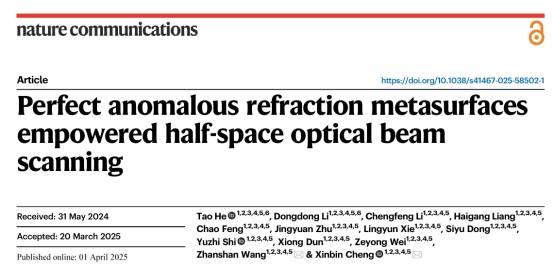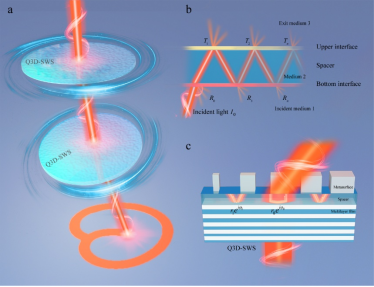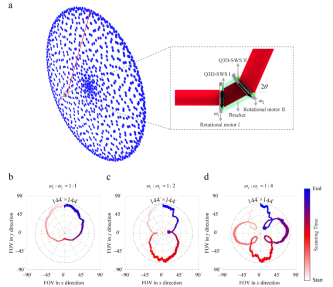Recently, the team of professor Zhanshan Wang and Xinbin Cheng from the School of Physical Science and Engineering at Tongji University proposed a high-efficiency half-space optical beam scanning system based on perfect anomalous refraction metasurfaces. This work pioneers a novel approach to the design of high-efficiency anomalous refraction metasurfaces, driving the practical application of light detection and ranging systems. The related research findings titled “Perfect Anomalous Refraction Metasurfaces Empowered Half-Space Optical Beam Scanning” have been published in “Nature Communications”.

Metasurface-based optical beam scanning devices have garnered significant attention in the fields of optics and photonics due to their potential to revolutionize light detection and ranging systems. However, achieving high-efficiency anomalous refraction remains a critical challenge in the field of metasurfaces, primarily due to the difficulty in suppressing reflection loss and spurious diffraction. These limitations constrain both the efficiency and the field of view (FOV) of metasurface-based optical beam scanning devices.
To address this, the research team proposed a high-efficiency half-space optical beam scanning system based on perfect anomalous refraction metasurfaces, as illustrated in Figure 1. To realize perfect anomalous refraction, the team introduced the concept of enhancing longitudinal degrees of freedom to arouse a multiple scattering process, thereby optimizing symmetry breaking. A quasi-three-dimensional subwavelength structure integrating metasurfaces with multilayer films was developed. To eliminate reflection loss and spurious diffraction, a multilayer film with specifically designed amplitude and phase responses was incorporated. This film exhibits high transmittance to zeroth-order propagating waves and high reflectance to first-order propagating waves. Through this design, the research team successfully achieved perfect anomalous refraction for the first time, with a polarization-insensitive absolute efficiency exceeding 99%.

Figure 1. High-efficiency half-space optical beam scanning system based on perfect anomalous refraction metasurfaces
The research team employed magnetron sputtering deposition, electron beam lithography, and reactive ion etching to fabricate the quasi-three-dimensional subwavelength structures. Spectral characterization confirmed an anomalous refraction efficiency of up to 93%. Building upon this foundation, the team further proposed a cascaded quasi-three-dimensional subwavelength structure for an uncoaxial beam scanning system, as shown in Figure 2. By independently rotating the two cascaded quasi-three-dimensional subwavelength structures, the experimental setup successfully demonstrated half-space optical beam scanning, achieving a 144°×144° FOV with a maximum efficiency exceeding 86%. By reducing the rotational speed ratio, the scanning trajectory density can be increased, thereby enhancing resolution.

Figure 2. Cascaded optical beam scanning effect
This work offers a new perspective for designing high-efficiency metasurfaces and is expected to inspire the creation of high-performance meta-devices and meta-systems.
Assistant Professor Tao He and Postdoctoral Fellow Dongdong Li from Tongji University are the co-first authors of this paper. Professors Zhanshan Wang and Xinbin Cheng are the co-corresponding authors. Other authors who made significant contributions include Ph.D. students Chengfeng Li, Haigang Liang, and Chao Feng; Assistant Professors Jingyuan Zhu and Siyu Dong; Dr. Lingyun Xie; Professors Yuzhi Shi and Xiong Dun; and Associate Professor Zeyong Wei from Tongji University.
Link to the paper:https://doi.org/10.1038/s41467-025-58502-1
